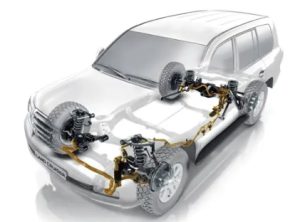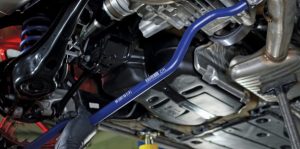When it comes to safe and comfortable driving, a vehicle’s suspension system plays a crucial role — and at the heart of that system lies an unsung hero: the stabilizer bar, also known as an anti-roll bar or sway bar. Though not always visible, stabilizer bars significantly influence how a car handles corners, reacts to bumps, and maintains tire contact with the road.
But how do stabilizer bars differ in the front and rear suspension systems? And why do some vehicles have them only at the front, while others use both? Let’s explore.
What Is a Stabilizer Bar?

A stabilizer bar is a U-shaped steel rod that connects opposite wheels of a vehicle through the suspension. It resists the body roll that occurs when a car corners by transferring forces from one side of the vehicle to the other.
Main Functions:
-
Reduces body roll during turns
-
Helps maintain tire contact with the road
-
Improves vehicle stability and safety
-
Enhances ride comfort on uneven terrain
Front vs. Rear Stabilizer Bars: Key Differences
| Feature | Front Stabilizer Bar | Rear Stabilizer Bar |
|---|---|---|
| Location | Connects left/right front suspension arms | Connects left/right rear suspension arms |
| Primary Purpose | Reduces front-end roll; enhances steering | Controls rear-end roll; helps cornering balance |
| Vehicle Type Use | Common in all vehicles | Often in performance or AWD vehicles |
| Impact on Handling | Directly affects turn-in response | Balances oversteer/understeer characteristics |
| Load Distribution | Handles engine/front load | Affects rear axle load distribution |
| Tuning Sensitivity | More sensitive to size/stiffness changes | Offers fine-tuning of handling balance |
How Stabilizer Bars Work in Front Suspension
In most vehicles, especially front-wheel drive (FWD) models, the front stabilizer bar is a standard feature.
Key Benefits:
-
Reduces the tendency of the car to lean forward or dive during sharp turns.
-
Keeps the front wheels more level, improving steering precision.
-
Essential for vehicles with front-heavy weight distribution (e.g., engine in front).
Front bars are typically thicker and stronger, as they deal with the bulk of the vehicle’s load and dynamic movement.
Rear Stabilizer Bars: Complement or Necessity?
Rear stabilizer bars are not standard in all vehicles but are common in performance, AWD, or rear-wheel drive (RWD) vehicles. Their main function is to:
-
Control rear body roll
-
Improve cornering balance, especially at high speeds
-
Reduce oversteer or understeer, depending on configuration
Vehicles That Commonly Use Rear Stabilizer Bars:
-
Sports cars (BMW M3, Audi S4, etc.)
-
SUVs with AWD systems
-
Trucks with heavy-duty suspension
-
Vehicles with independent rear suspension (IRS)
Front vs. Rear Bar Tuning: Handling Balance
Handling is about balance. Too much stiffness at one end of the car can cause understeer (car pushes forward) or oversteer (rear end slides out).
| Scenario | Handling Behavior | Solution via Stabilizer Bars |
|---|---|---|
| Too much front stiffness | Understeer | Soften front bar or stiffen rear bar |
| Too much rear stiffness | Oversteer | Soften rear bar or stiffen front bar |
| Balanced cornering desired | Neutral handling | Match front and rear bars according to driving style |
Do You Need Both Front and Rear Stabilizer Bars?
It depends on the vehicle and driving purpose:
| Use Case | Front Bar Needed | Rear Bar Needed | Reason |
|---|---|---|---|
| Daily commuter (FWD) | Yes | Optional | Front handles body roll; rear is less loaded |
| Off-road SUV (4WD) | Yes | Yes | Ensures stability on uneven terrain |
| Performance car (RWD) | Yes | Yes | Balance is critical during cornering |
| Compact car (budget) | Yes | Often omitted | Cost-saving, basic stability from front bar |
Maintenance & Replacement Tips
Just like any suspension part, stabilizer bars and their components can wear over time.
Signs of a Failing Stabilizer Bar or Links:
-
Clunking or rattling noises over bumps
-
Excessive body roll in corners
-
Vehicle feels unstable or “floaty”
-
Uneven tire wear
-
Loose or disconnected sway bar links
Maintenance Checklist:
-
Inspect stabilizer links and bushings regularly
-
Look for cracked rubber or metal fatigue
-
Replace both sides if one is worn
-
Torque to spec during installation
-
Consider upgrading if suspension is modified
Choosing the Right Stabilizer Bar Setup

When replacing or upgrading stabilizer bars, keep in mind:
-
Bar diameter: Thicker bars = stiffer response
-
Material: Solid steel vs. hollow for weight savings
-
Adjustability: Some performance bars allow fine-tuning via multiple link positions
-
Compatibility: Must match suspension type (MacPherson, double wishbone, etc.)
Where to Buy Stabilizer Bars & Components
Looking to upgrade or replace your stabilizer bar system?
Buy Stabilizer & Components online
This online store offers a wide selection of front and rear stabilizer bars, links, and bushings compatible with major car brands. Use their compatibility checker and get fast EU-wide delivery for both OEM and performance parts.
Final Thoughts
Though often overlooked, stabilizer bars are essential for safety, comfort, and control. Whether it’s the front bar keeping your steering sharp or the rear bar helping you corner with confidence, these components make a world of difference.
Understanding their role in front vs. rear suspension systems helps you:
-
Diagnose handling issues
-
Maintain proper vehicle balance
-
Choose the right setup for your driving style
Whether you’re a commuter, performance enthusiast, or off-road adventurer, the right stabilizer bar setup can dramatically improve your vehicle’s dynamics and handling precision.
Ready to enhance your suspension?
Buy Stabilizer & Components online and give your car the stability it deserves.